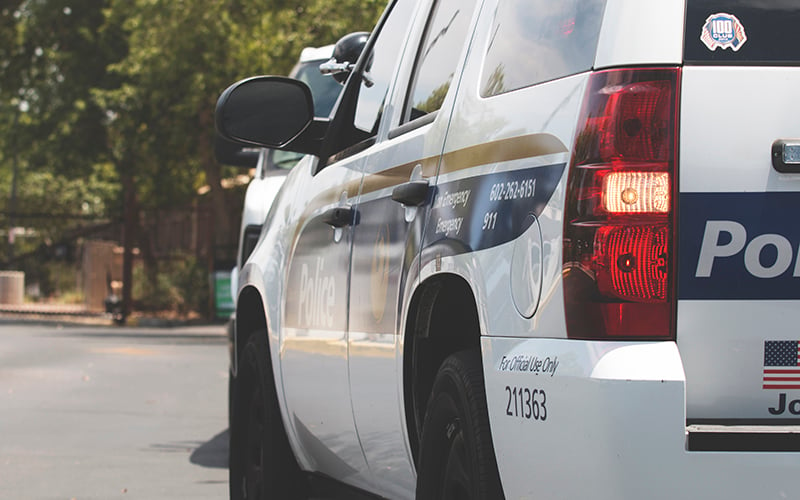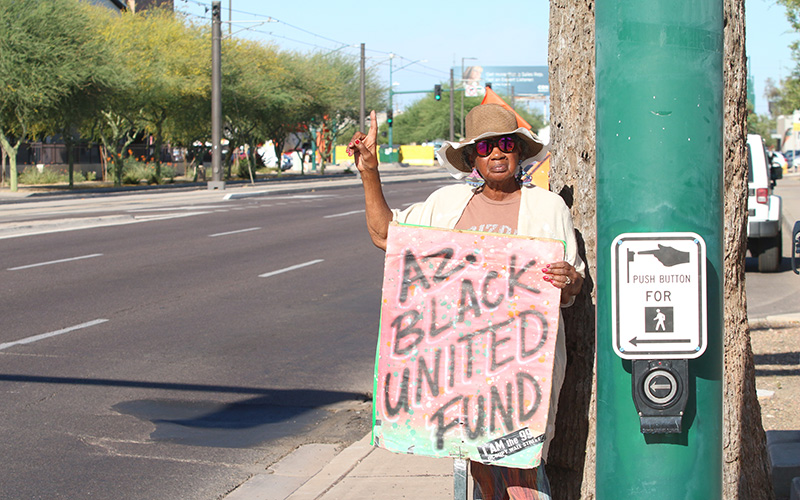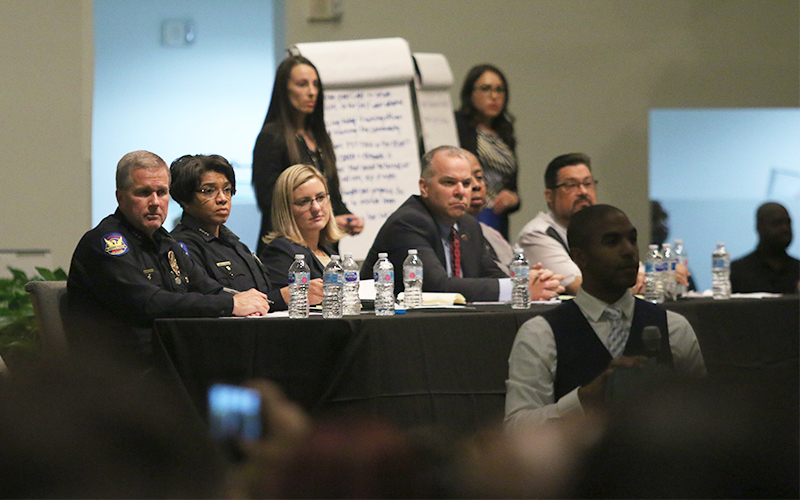
City officials, including then-Police Chief Jeri Williams and Mayor Kate Gallego, second and third from left, listen to residents’ complaints about police behavior during a June 2019 public meeting. (File photo by Tyler Dunn/Cronkite News)
PHOENIX – Jeri Williams, then-Phoenix’s police chief, faced a large and angry crowd at the Pilgrim Rest Baptist Church in June 2019 just days after her officers were captured on video pointing weapons and screaming obscenities at a young Black family.
“We are here because of trust, we are here because of transparency, we are here because of accountability,” Williams told the crowd packed in the pews of the church, according to a transcript of the meeting.
Audience members, many from Phoenix’s communities of color, pushed back as soon as the microphone was opened for them to speak.
The sister of Alejandro Hernandez, a Latino man shot and killed by Phoenix police, said her family had waited more than seven weeks for a police report about her brother’s shooting.
“I would disagree with you, Chief,” said the young woman, according to the meeting’s transcript. “We are here for a lack of trust, for a lack of transparency, and for a lack of accountability.”
The meeting four years ago was public and well-advertised.
But for more than a decade, the police department has attempted dialogue with the city’s diverse population more privately through Community Advisory Boards to the Chief (CABs).
The 12 boards represent the city’s diverse racial, ethnic and spiritual groups and meet to discuss policing in their communities.
The department has told city officials and the public that the boards are an important part of its strategy to build transparency and trust with residents, particularly among marginalized residents.
But the department releases virtually no information about what the 12 boards do, what they discuss or how – if at all – leadership incorporates any feedback from the boards into police tactics, the Howard Center for Investigative Journalism found in a review of police records.
The department also does not disclose who serves on advisory boards.
Members who the Howard Center found independently gave mixed reviews of the effectiveness of the boards. One former member said he was asked to leave the LGBTQ advisory board because he complained about the department’s lack of transparency, particularly with respect to hate crimes data.
The work of the boards also hasn’t made the radar of the Phoenix Office of Accountability & Transparency, established in May 2021 to provide civilian oversight of police operations and give the department feedback about the complaints that the office receives.
“We have not had any contact with them,” Roger Smith, the office’s director, said about the advisory boards. “I actually don’t know who’s on those boards or even what their purpose is.”
The scarcity of information about the work of the boards raises questions about the department’s commitment to community trust and transparency at a time when it is facing a serious moment in its history.
Since 2021, the department has been the subject of a Department of Justice pattern or practice investigation, a rare process that the justice department only initiates against police agencies suspected of the most serious civil rights violations.
The focus of the justice department investigation – allegations of excessive force, discriminatory policing practices and violations of constitutional rights – are among the same issues that led Phoenix community leaders to demand a trust-building dialogue with the department in 2010.
That year, a Black Phoenix city council member was handcuffed and thrown to the ground after he attempted to rush to the aid of neighbors whose home was on fire.
The resulting efforts ultimately led the department to establish a Community Engagement Bureau and dozens of programs to interact with Phoenix residents.
Unlike programs that sought to educate residents about policing, such as ride-alongs with officers, the community advisory boards to the chief were designed to be listening forums for residents to give feedback on issues of concern.
And they were specifically developed to engage marginalized communities, such as Phoenix’s Black and Latino communities, its LGBTQ community, Muslim residents and even refugees – all communities that have reported among the worst interactions with Phoenix police.
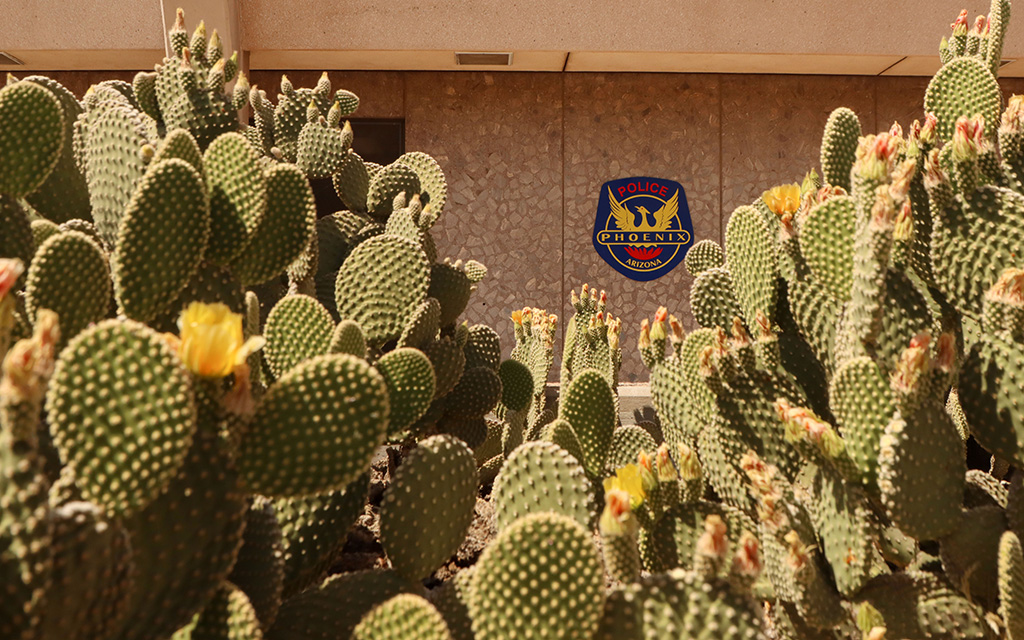
The Phoenix Police Department is under a pattern or practice investigation from the U.S. Department of Justice, with discriminatory policing practices listed as one of the five areas of concern. (Photo by Shelby Rae Wills/Howard Center for Investigative Reporting)
Checking a box?
Alan Zeichick is the vice chair of the Jewish Community Advisory board and a member of a local synagogue, Temple Chai, where he also has served on the security committee.
Zeichick said he wanted to work with the Jewish CAB because he once worked as a firefighter and has an interest in public safety.
In his experience, getting police officers involved in conversations regarding public safety and working with his community has not been a problem.
“The relationship of the organized Jewish community with law enforcement in Phoenix is typically excellent,” he said. “We look at them … as trusted partners.
“Not every group has that same relationship, as you know, with the police,” Ziechick said.
Usama Shami, president of the Islamic Community Center of Phoenix, said the Phoenix police department’s engagement with his community has waxed and waned over the years.
The commitment, he said, has varied with each new police chief and each new mayor.
“When those boards started forming, there was value in those meetings,” he said.
“But then with time, it just became a meet and greet with no actual benefit,” Shami said.
“Basically, it goes back to what the police department is looking at,” he continued. “Are they looking to improve their relationship with different communities … or is this whole thing just basically to check a box?”
Patrick Kelley got involved in the LGBTQ CAB around 2006, following a renewed effort on the part of the city and the police department to improve community relations.
Kelley became co-chair of the committee and believed that it made progress toward helping the police department understand the concerns of the LGBTQ community. But that progress suffered with changes in the department’s leadership that led to less transparency.
The advisory boards started meeting less frequently, he said, and board meetings went from public to private. Then, the police stopped giving community advisory boards monthly hate crime statistics regarding their community.
Kelley was asked to step down from his position as a board member in 2017 after he used stage time at a summit meeting of all the boards to complain about a lack of transparency over hate crime statistics and the backsliding he saw in policing.
Today, Kelley runs a prominent business that includes resources for the LGBTQ community, such as vaccinations for monkeypox, COVID-19 and HIV testing.
Kelley said he was unaware of who the police liaison for the LGBTQ community even was.
“As a member of the community, why has she not introduced herself?” he asked.
Public information on CABs sparse
Public records also paint a mixed picture of the advisory board’s activities.
At city council meetings over the years, police officials have told city officials that the 12 advisory boards each meet four times a year.
But the boards have never met quarterly, according to the Community Engagement Bureau’s bi-annual reports. From 2018 to 2020, they held half the number of board meetings they claim on the police department’s web page devoted to the boards.
From the data, it’s unclear if any specific board meets four times a year, or not at all.
Sgt. Hugo Lopez leads the Community Response Squad and supervises the liaisons to the community engagement boards.
In an interview, Lopez expressed general knowledge of how the boards worked.
The department does not post minutes of any of the meetings because minutes are not taken, he said.
“It’s more open, more casual, more personal,” Lopez said.
In reports to city council and others posted on the department’s website, reporters found only one description of how an advisory board informed police procedures in the past 14 years.
In September 2019, “staff met with PD Advisory Board members to discuss mental health issues, crisis response and treatment needs in the community,” former chief Williams wrote in a memo to then-Assistant City Manager Milton Dohoney, Jr.
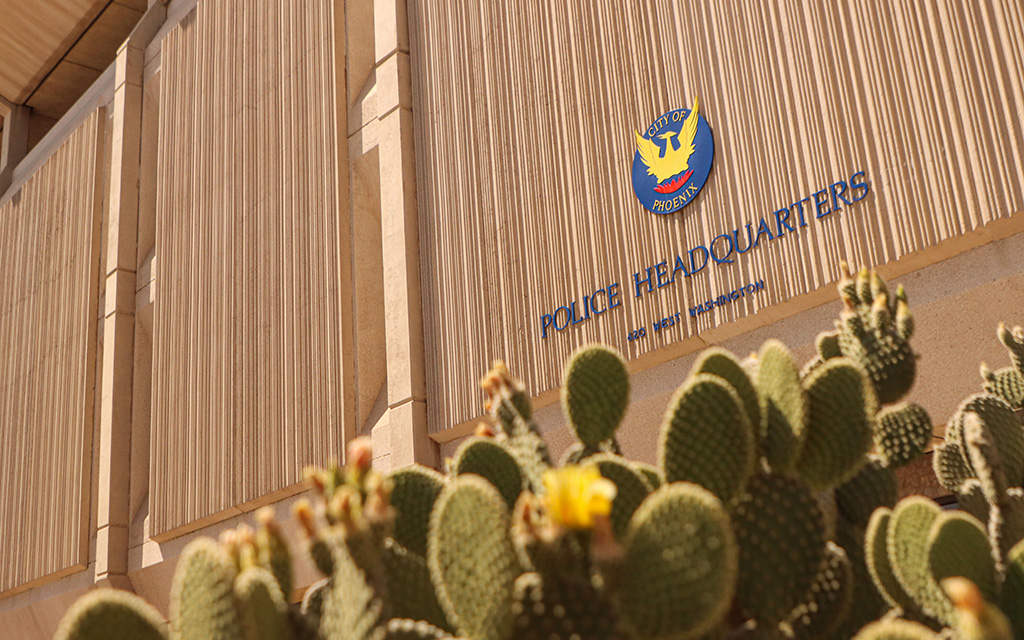
The Phoenix Police Department advertises that it houses 12 Community Advisory Boards, which are meant to improve relationships with marginalized communities. (Photo by Shelby Rae Wills/Howard Center for Investigative Reporting)
Department tight-lipped
The 12 community advisory boards in Phoenix include the African American Advisory Board; the American Indian Advisory Board; the Arab Advisory Board; the Asian Advisory Board; the Cross-Disability Advisory Board; the Faith Based Advisory Board; the Hispanic Advisory Board; the Jewish Advisory Board; the LGBTQ Advisory Board; the Muslim Advisory Board; the Refugee Advisory Board; and the Sikh Advisory Board.
Community members who are interested in joining the boards apply through the city’s portal for boards and commissions. Membership is not automatic. The department choses who can sit on the boards, and those selected are asked to undergo training to gain an “understanding of 21st Century Policing,” according to the website.
Billie Branch is the CEO and president of Branch International, a local nonprofit with programs that assist in transitions to economic stability for individuals facing a range of hardships such as poverty and addiction.
Branch has served on the Cross-Disability Advisory Board since 2017, and was also selected to serve on the Phoenix Police Department Honors Advisory Board, which reviews and votes for quarterly police officer awards.
She said she decided to join the board because she wanted to advocate for invisible disabilities, such as mental health, in marginalized communities of Phoenix.
Branch said the two-way communication between the community and the police will build back trust with the community.
“I love empowering the community, and I’m here to support the community as well as the Phoenix Police Department collaboratively together,” she said. “I just think that it would be good for us to work together to keep our communities and our family safe.”
Each advisory board has a police liaison who is listed as a contact on the department’s website, with some detectives having responsibility for more than one board.
Five years ago, the department assigned 19 officers to the advisory boards and each board had two liaisons, according to public records from 2017. The current boards are served by eight liaisons.
When the Howard Center asked to speak to the department’s liaisons to the CABs, a department spokesman said the department could not force liaisons to speak to the media. None did.
After a month of back and forth with the department, Sgt. Phil Krynsky issued a statement that reiterated information about the advisory boards found on the department’s website.
“The board is designed to identify community concerns and communicate with members on how to best address these issues,” Krynsky wrote. “The primary goal is to maintain a positive relationship with all community groups.”
‘Pro forma effort’
In 2020, researchers with the Policing Project at New York University School of Law studied community advisory boards across the country, and focused on four major ones, including those in Phoenix.
In their published report, “Community Advisory Boards: What Works and What Doesn’t,” the authors found that boards at major departments across the country suffered from a number of deficiencies that inhibited their ability to fulfill their mission, including a weak commitment from departments and community members to keep them going; poorly defined objectives or ones that members cannot agree upon; a lack of technical knowledge about policing methods; and a lack of overall diversity.
“Too often, CABs represent a pro forma effort by policing agencies to signal a commitment to working with the public, without really working with the public,” the authors wrote. “Membership becomes stagnant, communication runs in one direction, members feel disempowered, and police-community relations don’t improve in any notable way.”
In Phoenix, the authors questioned the wisdom of having police select advisory board members because the community could perceive members as representing the department’s priorities, not the community’s.
The authors also questioned the wisdom of creating separate advisory boards for different groups because of the potential to leave some identity groups out.
But in Phoenix, the authors said the strategy was a good one.
“With this structure, the Police Department can devote attention to the particular needs of each of the twelve … communities,” they wrote.
“Yet Phoenix’s structure is not without its difficulties,” they continued. “By organizing CABs in this way, the Phoenix Police Department limits its ability to understand and efficiently attend to issues that exist across these communities, or outside of them.
“The closed meeting style also means that the existence of the boards is not as well known among the public as it could be.”
In conclusion, the authors said that well-organized, active advisory boards with clear missions and good working relationships with police can be an integral part of a department’s community engagement strategy, and “heighten the influence of a community voice in policing.”
“But too many of these CABs are dormant, ineffective, or otherwise not well-positioned to provide actionable advice,” the authors said. “This is a serious underutilization of CABs’ potential to connect policing agencies with community perspectives.
“The simple fact is, that unless the sorts of guidance offered here is adopted, it is probably better not to have a CAB – rather than an ineffectual or rubber-stamp one.”
This story was produced by the Howard Center for Investigative Journalism at Arizona State University’s Walter Cronkite School of Journalism and Mass Communication, an initiative of the Scripps Howard Foundation in honor of the late news industry executive and pioneer Roy W. Howard. Contact us at [email protected] or on Twitter @HowardCenterASU.
